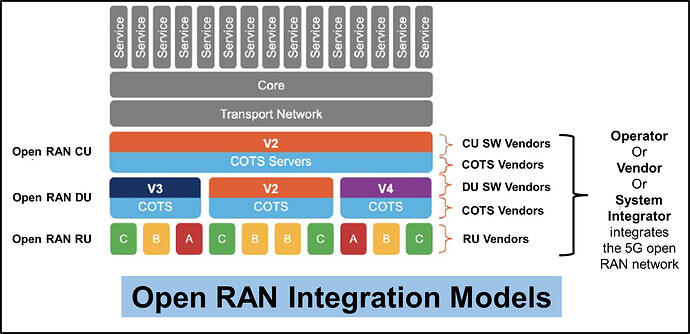How can we integrate 5G Nodes in an Open RAN Network?
My friend: Hi Ibrahim, I have a question for you.
Me: Please, go ahead.
My friend: I was wondering if the integration of 5G network components in Open RAN is a problem due to having many vendors or not?
Me: Actually, integration is one of the big challenges in Open RAN. So, if you want to integrate a 5G network using Open RAN technology that consists of O-RUs, O-DUs, and O-CUs where all of it are just SW deployed over COTS HW using different vendors for SW and HW connected together using open interfaces, so you may have some difficulties especially for the interoperability between all vendors. Also, if a network failure happens, many parties can be blamed such as the HW vendor, the SW vendor, the system integrator, etc. as there is no one neck to choke ![]()
My friend: But how can we do integration in 5G networks using Open RAN?
Me: We have mainly three models which are: Model 1 (MNO integrates itself), where the operator will do the integration using its own in-house technical human resources that are capable of managing the integration between different Open RAN components and vendors such as Rakuten. With operators managing the integration, it is expected that the long-term costs would be far lower as compared to those of vendors selling proprietary kits. Model 2 (Vendor integrates), where a SW or HW vendor becomes responsible for the integration and would work with all other Open RAN partners for the operator to deliver the Open RAN network such as Fujitsu in DISH network. Model 3 (System Integrator), where a system integrator company manages the Open RAN network and does the integration between all vendors on behalf of the operator such as in Peru, Telefónica has relied on a Spanish systems integrator called Everis.
My friend: So, it seems that integration in Open RAN is different from conventional networks, right?
Me: Yes, that’s true. To integrate Open RAN, a new approach is needed, so integration of Open RAN needs to be built for a software-centric world where software talks to all physical components, at any time, to deliver scalability, innovation and changing the game for how open networks are integrated. In the past, SW was tied to a physical element from a particular vendor, which created a vendor lock-in and required a HW change with any vendor swap. Today, HW is COTS-based, and SW can be remotely upgraded or swapped. So, ease of integration is enabled through open interfaces.
My friend: Thank you so much. You made it very clear.
Me: You are most welcome.
